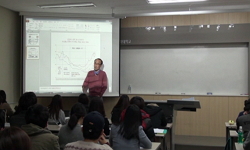Background and Aim: Social stigma and discrimination associated with HIV/AIDS are viewed as one of the greatest challenges for the female HIV/AIDS patients. HIV-infected female patients are considered socially unusual. They are unpleasantly different ...
http://chineseinput.net/에서 pinyin(병음)방식으로 중국어를 변환할 수 있습니다.
변환된 중국어를 복사하여 사용하시면 됩니다.
- 中文 을 입력하시려면 zhongwen을 입력하시고 space를누르시면됩니다.
- 北京 을 입력하시려면 beijing을 입력하시고 space를 누르시면 됩니다.
Social Stigma and Quality of Life in the Female HIV/AIDS Patients = Social Stigma and Quality of Life in the Female HIV/AIDS Patients
한글로보기https://www.riss.kr/link?id=A106435840
- 저자
- 발행기관
- 학술지명
- 권호사항
-
발행연도
2018
-
작성언어
-
- 주제어
-
자료형태
학술저널
-
수록면
203-204(2쪽)
- 제공처
-
0
상세조회 -
0
다운로드
부가정보
다국어 초록 (Multilingual Abstract)
Background and Aim:
Social stigma and discrimination associated with HIV/AIDS are viewed as one of the greatest challenges for the female HIV/AIDS patients. HIV-infected female patients are considered socially unusual. They are unpleasantly different from the public and threatening to the public. Stigmatization from the disease deeply degrades the person's overall quality of life. Stigma and discrimination are world events which seriously affect the lives of people with HIV/AIDS. Culturally, women are exposed to more stigma, especially women living with HIV are blamed of sexual deviances and adul-tery. Several studies have implied that women have been more vulnerable to stigma, especially when HIV/AIDS is mentioned as a transmittable sexual disease. The purpose of the study is to examine the relationships between social stigma and quality of life in female HIV/AIDS patients.
Methods:
This research used a descriptive study design. Data were collected using Stigma Scale for Receiving Psychological Help to measure social stigma and SF-12 to measure quality of life. A convenience sample of 78 female HIV/AIDS patients was recruited in C general hospital in C city. Data were analyzed with number, percentage, Pearson’s correlation, and multiple regression analysis using SPSS/Win 25.0. Inclusion criteria were age of 20 years or over and female HID/AIDS participants who were able to understand the purpose of the study and agreed to participate in this study.
Result:
Out of 78 participants, the majority was Caucasian (n=34; 45.6%), not married (n=64; 82.1%), employed (n=62; 79.5%), Bachelor’s degree earned (n=60; 76.9%), protestant affiliation (n=40; 51.3%), and middle class socioeconomic status (n=52; 66.7%). Most of the participants reported their previous awareness of HIV/AIDS (n=46; 59.0%). Participants’ average age was 48.03 (±8.11) and duration of illness in year was 2.10(±0.58).
There was a significant positive correlation between quality of life physical component summary and previous awareness of HIV/AIDS (r=.31, p<.01); and between social stigma and duration of HIV/AIDS illness in years (r=.84, p<.01). There was a significant negative correlation between social stigma and quality of life physical component summary (r=-.45, p<.01); between social stigma and quality of life mental component summary (r=-.32, p<.01); between duration of HIV/ AIDS illness in years and quality of life physical component summary (r=-.56, p<.01); and between duration of HIV/ AIDS illness in years and quality of life mental component summary (r=-.28, p<.01).
The regression model significantly explained 39% of the variances in terms of quality of life physical component summary; the most influential factor to predict quality of life physical component summary was socioeconomic status (β=.463, p<.01). The participant’s race ethnicity (β=.254, p<.01), religion (β=.087, p<.01), the duration of HIV/AIDS illness in years (β=-.050, p<.01), and social stigma (β=-.027, p<.01) were also significant predictors for quality of life physical component summary. The regression model significantly explained 16% of the variances in terms of quality of life mental component summary; the most influential factor to predict quality of life mental component summary was social stigma (β=-.427, p<.01). The duration of HIV/AIDS illness in years (β=-.387, p<.01) and previous awareness of HIV/AIDS (β=.125, p<.01) were also significant predictors for quality of life mental component summary.
Conclusion:
Social stigma, race ethnicity, religion, and the duration of HIV/AIDS illness in years play an important role in patients' quality of life physical component summary and hinder them from accessing the treatment. Social stigma, the duration of HIV/AIDS illness in years, and previous awareness of HIV/AIDS are considerably important predicting factors to quality of life mental component summary. The results may be crucial to develop strategy in order to decrease the disease prevalence. As HIV/AIDS infection is increasing in worldwide, it is neces-sary to plan and practice proper strategies for eliminat-ing wrong conception among public, families and medi-cal teams, by which stigma could be reduced to the least extend. According to the findings, HIV/AIDS stigma has a negative impact on the society and it has been a barrier for the participants to access and gain equal social and medical rights. The insufficient knowledge, miscon-ceptions about the transmission ways, and the fear of be-ing infected as a woman may lead to inappropriate social behaviors towards. In conclusion, a cultural background for the public as well as a general knowledge about HIV/AIDS may contribute to positive attitudes for patients' health care.
동일학술지(권/호) 다른 논문
-
Factors Affecting Appropriate Antenatal Care USE Among Women in Uganda: a case of Kabarole District
- 한국모자보건학회
- 김소현
- 2018
-
실내 미세먼지 노출이 가정주부의 대사 증후군에 미치는 영향: 예비연구결과
- 한국모자보건학회
- 오종민
- 2018
-
- 한국모자보건학회
- 은병욱
- 2018
-
- 한국모자보건학회
- 최지연
- 2018




 KISS
KISS



